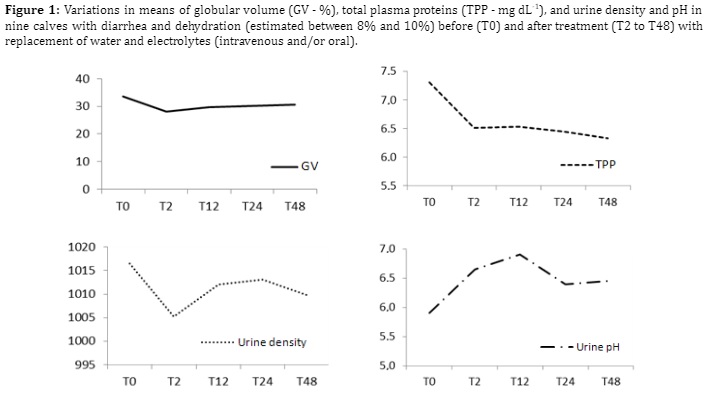Naturally acquired diarrhea in calves from birth to 25 days of age: incidence, clinical Signs, and response to treatment
DOI:
https://doi.org/10.21708/avb.2023.17.3.11758Resumo
Diarrhea has a multifactorial etiology and is one of the main diseases affecting dairy calves, promoting high mortality rates in the first weeks of life. This study aimed to assess diarrhea incidence and clinical aspects, as well as clinical responses to treatment (oral and intravenous) with electrolyte solutions. A total of 40 crossbred newborn calves were subjected to daily physical examination until 25 days. Calves with diarrhea (score 3) and dehydration (8% to 10%) received electrolyte replacement therapy orally or intravenously, according to estimated fluid loss, as well as a maintenance volume (oral). Blood and urine samples were collected between 16 and 24 hours after birth and at 5, 10, 15, 20, and 25 days; in diarrheic animals, these materials were collected immediately after the identification of diarrhea and at 2, 12, 24, and 48 hours after treatment initiation. Globular Volume (GV) and Total Plasma Proteins (TPP) were evaluated, in addition to physicochemical urine characteristics. Failures in the transfer of passive immunity may have contributed to the occurrence of diarrhea in 30 calves (75%), which maintained good body condition with no complications. Urine analysis showed a higher pH in non-diarrheic calves (6.7) compared to diarrheic calves (6.2) (p=0.0029), indicating acidification; higher GV, TPP, and urine density were found for diarrheic calves, with reductions 2 hours after hydration and slight variations up to 48 hours, indicating the effectiveness of hydration and acidosis correction.
Downloads

Downloads
Publicado
Edição
Seção
Licença
Copyright (c) 2023 Acta Veterinaria Brasilica

Este trabalho está licenciado sob uma licença Creative Commons Attribution 4.0 International License.
Autores que publicam na Acta Veterinaria Brasilica concordam com os seguintes termos: a) Autores mantém os direitos autorais e concedem à revista o direito de primeira publicação, com o trabalho simultaneamente licenciado sob a Licença Creative Commons Attribution que permite o compartilhamento do trabalho com reconhecimento da autoria e publicação inicial nesta revista. b) Autores têm autorização para assumir contratos adicionais separadamente, para distribuição não-exclusiva da versão do trabalho publicada nesta revista (ex.: publicar em repositório institucional ou como capítulo de livro), com reconhecimento de autoria e publicação inicial nesta revista. c) Autores têm permissão e são estimulados a publicar e distribuir seu trabalho online (ex.: em repositórios institucionais ou na sua página pessoal) a qualquer ponto antes ou durante o processo editorial, já que isso pode gerar alterações produtivas, bem como aumentar o impacto e a citação do trabalho publicado (Veja O Efeito do Acesso Livre).


 Esta obra está licenciada com uma Licença
Esta obra está licenciada com uma Licença 